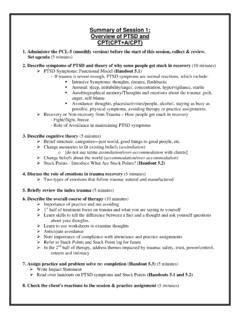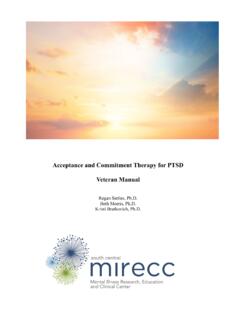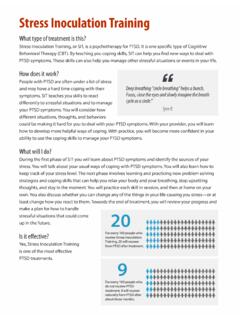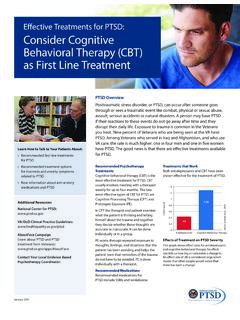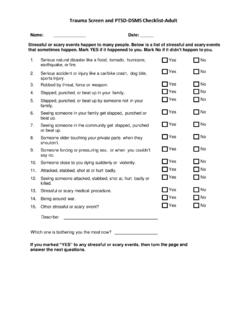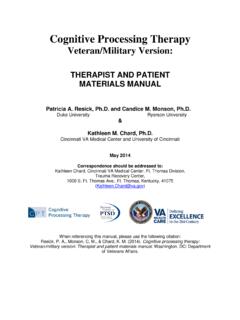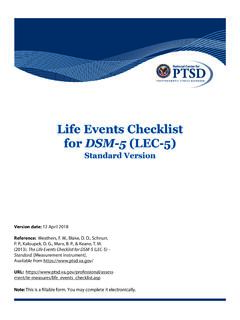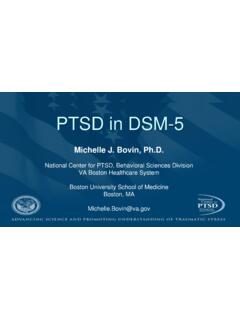Transcription of Summary of Session 1: Overview of PTSD and CPT
1 Summary of Session 1: Overview of ptsd and CPT 1. Administer the PCL-5 (monthly version) before the start of this Session , collect & review. Set agenda (5 minutes) 2. Describe symptoms of ptsd and theory of why some people get stuck in recovery (10 minutes) ptsd Symptoms: Functional Model (Handout ) - If trauma is severe enough, ptsd symptoms are normal reactions, which include: Intrusive Symptoms: thoughts, dreams, flashbacks Arousal: sleep, irritability/anger, concentration, hypervigilance, startle Autobiographical memory/Thoughts and emotions about the trauma: guilt, anger, self-blame Avoidance: thoughts, places/activities/people, alcohol, staying as busy as possible, physical symptoms, avoiding therapy or practice assignments. Recovery or Non-recovery from Trauma How people get stuck in recovery - Fight/flight, freeze - Role of Avoidance in maintaining ptsd symptoms 3.
2 Describe cognitive theory (5 minutes) Belief structure: categories just world, good things to good people, etc. Change memories to fit existing beliefs (assimilation) o [do not use terms assimilation/over-accommodation with clients] Change beliefs about the world (accommodation/over-accommodation) Stuck Points - Introduce What Are Stuck Points? (Handout ) 4. Discuss the role of emotions in trauma recovery (5 minutes) Two types of emotions that follow trauma: natural and manufactured 5. Briefly review the index trauma (5 minutes) 6. Describe the overall course of therapy (10 minutes) Importance of practice and not avoiding 1st half of treatment focus on trauma and what you are saying to yourself Learn skills to tell the difference between a fact and a thought and ask yourself questions about your thoughts.
3 Learn to use worksheets to examine thoughts Anticipate avoidance Note importance of compliance with attendance and practice assignments Refer to Stuck Points and Stuck Point log for future In the 2nd half of therapy, address themes impacted by trauma: safety, trust, power/control, esteem and intimacy 7. Assign practice and problem solve re: completion (Handout ) (5 minutes) Write Impact Statement Read over handouts on ptsd symptoms and Stuck Points (Handouts and ) 8. Check the client s reactions to the Session & practice assignment (5 minutes) Summary of Session 2: Examining the Impact of Trauma 1. Administer PCL-5 (in waiting room if possible), collect & review. Set agenda. (5 minutes) 2. Have client read Impact Statement aloud (5 minutes) If practice not written, address nonadherence to the assignment (do this for all practice assignments in CPT).
4 Also, have client describe meaning of event orally and reassign impact statement. 3. Discuss meaning of Impact Statement with patient & identify Stuck Points (10 minutes) Begin to identify Stuck Points & add Stuck Points to the Stuck Point Log (Handout ) Review major issues to be focused on in treatment Therapist looks for the following: (do not use these terms with client) - Assimilation (changing memories to fit beliefs) - Over-accommodation (going overboard on changing beliefs as a result of memories) - Accommodation (changing beliefs about the world and is desirable) 4. Examine connections among events, thoughts, and feelings (Handout ) (10 minutes) Basic emotions: angry, disgusted, sad, scared, happy Combined: jealous = mad + scared Varying intensity: irritated/angry/enraged Manufactured emotions (based on our thoughts): guilt, shame.
5 Patient examples of own feelings, including physical sensations Interpretation of events/self-talk affecting feelings (snubbed on street), alternatives Go back to Impact Statement for personal application to practice labelling emotions and noticing the connection between thoughts and feelings 5. Introduce A-B-C Worksheets and fill one out together (Handout ) (5 minutes) 6. Describing Stuck Points more fully (5 minutes) Describing them in routine examples and trauma related events Introduce Stuck Point Help Sheet (Handout ) - (Utilize Therapist Stuck Point Guide as reference Figure ) 7. Assign practice (Handout ) (5 minutes) Complete A-B-C Worksheets to become aware of connection among events, thoughts, feelings, and behavior At least one A-B-C Worksheet each day (as soon after an event as possible), at least one worksheet directly about the Index Trauma Add to Stuck Point Log If the client did not write Impact Statement, re-assign this in addition to completion of ABC Worksheets 8.
6 Check-in re: client s reactions to Session & practice assignment (5 minutes) ** Therapist should make a copy of the Stuck Point log to hold on to** Summary of Session 3: Working with Events, Thoughts, and Feelings 1. Administer PCL-5 (in waiting room if possible), collect & review. Set agenda. (5 minutes) 2. Review completion of practice assignments. (5 minutes) If impact statement was not completed for Session 2, but was for Session 3, therapist should have client read it aloud and find any new Stuck Points. If the client has not done any assignments, address nonadherence. 3. Review A-B-C Worksheets, assist in labeling thoughts and feelings in response to events (15 minutes) If worksheets completed, praise efforts and provide any corrections in a low key manner Label thoughts vs.
7 Emotions Recognize changing thoughts can change intensity of type of feelings - Begin challenging self-blame and guilt Point out mismatches: - Dominant emotion(s)? - Emotions follow thoughts? - Dominant thought(s)? - Thoughts and emotional intensity match? Look for Stuck Points, add them to the log, and use Socratic questioning to help patient identify alternative hypotheses 3. Discuss the A-B-C Worksheet related to trauma to challenge assimilated thoughts (15 minutes) Do one together if patient did not complete Focus on identifying assimilated Stuck Points Challenge the assimilated Stuck Point ( , self-blame) using Socratic questioning 5. Assign practice (Handout ) (5 minutes) Daily completion of A-B-C Worksheets - at least one per day on the index trauma or other traumas Additional worksheets can be on day-to-day events 6.
8 Check-in re: client s reactions to Session & practice assignment (5 minutes) Summary of Session 4: Examining the Index Event 1. Administer PCL-5 (in waiting room if possible), collect & review. Set agenda. (5 minutes) 2. Review A-B-C Worksheets, prioritizing assimilated thoughts (10 minutes) Add any new Stuck Points to the Stuck Point Log Ensure emotions are accurately labeled 4. Address client s assimilated Stuck Points using Socratic dialogue to clarify and examine. (10 minutes) Identify context of trauma (use of clarifying questions) , What else might you have done? And what might have happened then? Discuss hindsight bias and outcome based reasoning 5. Explain difference between responsibility and blame (5 minutes) Introduce Levels of Responsibility Handout (Handout ) Help client differentiate among blame/intent, responsibility, and the unforeseeable 6.
9 Introduce Challenging Questions Worksheet (Handout ) to help patient challenge Stuck Points (10 minutes) Go through blank question worksheet Go through example worksheets (Handout and ) Review the Guide for the Challenging Questions Worksheet (Handout ) Choose a Stuck Point to begin addressing with these questions (a focus on assimilation is helpful at this point in the therapy) 7. Assign practice (Handout ) (5 minutes) Daily completion of the Challenging Questions Worksheet, using one Stuck Point a day 8. Check-in re: client s reactions to Session & practice assignment (5 minutes) Summary of Session 5: Using the Challenging Questions Worksheet 1. Administer PCL-5 (in waiting room if possible), collect & review. Set agenda. (5 minutes) 2. Review Challenging Questions Worksheet (25 minutes) Assist client in answering questions they had difficulty answering Assist client to analyze and confront Stuck Points Focus on assimilated Stuck Points first.
10 Even if assimilated Stuck Points are resolved, complete a challenging questions work to reinforce. Use of Socratic Dialogue to help client elaborate. 4. Introduce Patterns of Problematic Thinking Worksheet (10 minutes) Go over blank handout (Handout ) Go over example (Handout ) Questions to consider or address: Does the patient have tendency toward particular patterns of problematic thinking? Help client generate more possible examples of problematic thinking patterns, trauma and non-trauma-related, using the Patterns of Problematic Thinking Worksheet Describe how these patterns become automatic, creating negative feelings (use example) or causing people to engage in self-defeating behavior (use example) - What other events in your life has this kind of thinking affected?
